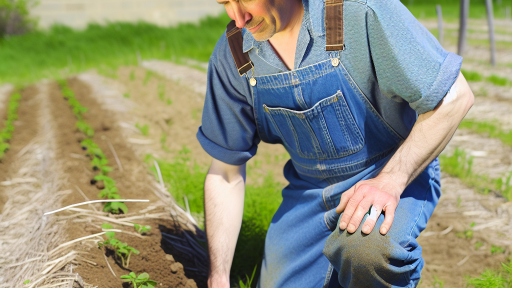Introduction
Sustainable farming is crucial in preserving our environment and ensuring food security.
Importance of sustainable farming
Sustainable farming is a method that focuses on long-term environmental health, economic profitability, and social equity.
It aims to produce food while minimizing negative impacts on the environment.
It is important because it maintains soil health, reduces pollution, conserves water, and promotes biodiversity.
The purpose of the blog post
In this blog post, we will discuss 8 sustainable farming hacks that can help farmers improve their practices and contribute to a more sustainable agricultural system.
These hacks cover various aspects of sustainable farming, including soil health, water conservation, pest control, and more.
By implementing these hacks, farmers can enhance the sustainability of their operations while also increasing efficiency and productivity.
Implement crop rotation
Crop rotation is a sustainable farming practice where different crops are planted in the same area over a period of time.
This method offers numerous benefits to both the soil and the crops themselves.
Benefits of crop rotation
- Improves soil fertility: Different plants require different nutrients, so rotating crops helps maintain soil health by preventing nutrient depletion.
- Reduces pests and diseases: Planting the same crop year after year can attract pests and diseases, but crop rotation disrupts their lifecycle and reduces the need for chemical pesticides.
- Controls weeds: Rotating crops can help control the growth of weeds by interrupting their lifecycle and reducing their prevalence in the field.
- Increases yield: By rotating crops, farmers can enhance soil quality and structure, leading to higher yields and better overall crop health.
Examples of suitable crop rotations
- Corn – Soybeans – Wheat: This rotation helps improve soil fertility by alternating between nitrogen-fixing legumes and nutrient-demanding grains.
- Potatoes – Brassicas – Legumes: This rotation helps control pests and diseases, as each crop has different susceptibility to common pathogens.
- Tomatoes – Onions – Carrots: This rotation helps manage weeds effectively, as each crop suppresses different types of weeds and reduces competition.
By implementing crop rotation on your farm, you can enhance soil health, reduce the need for chemical inputs, and ultimately improve the sustainability of your farming practices.
Utilize cover crops
Implementing cover crops is a sustainable farming practice that offers a myriad of benefits.
These crops are grown primarily to protect and improve the soil rather than for the purpose of harvesting.
Advantages of cover crops in sustainable farming
- Prevent soil erosion: Cover crops help hold the soil in place, reducing erosion caused by wind and water.
- Enhance soil fertility: These crops add organic matter to the soil, improving its structure and nutrient content.
- Suppress weeds: Cover crops outcompete weeds for light, water, and nutrients, reducing the need for herbicides.
- Improve water infiltration: The root systems of cover crops enhance water infiltration and reduce surface runoff.
- Provide habitat for beneficial insects: Some cover crops attract pollinators and other beneficial insects that help control pests.
Different types of cover crops and their uses
- Legumes: Leguminous cover crops like clover and vetch fix nitrogen in the soil, reducing the need for synthetic fertilizers.
- Grasses: Grass cover crops such as rye and wheat protect the soil from erosion and improve soil structure.
- Brassicas: Cover crops like radishes and turnips break up compacted soil and scavenge nutrients from deep in the ground.
- Others: There are also cover crop mixes available, combining different species to maximize benefits for the soil.
By utilizing a diverse range of cover crops in your sustainable farming practices, you can reap the rewards of healthier soil, increased crop yields, and reduced environmental impact.
Overall, cover crops play a crucial role in sustainable agriculture by promoting soil health, reducing the need for synthetic inputs, and fostering biodiversity on farms.
Practice integrated pest management
Integrated Pest Management (IPM) is a holistic approach to managing pests in an environmentally responsible way.
It focuses on preventing pest problems by using a combination of techniques including biological control, habitat manipulation, and crop rotation.
Concept of Integrated Pest Management
IPM aims to minimize the use of chemical pesticides by incorporating other methods to control pests.
This approach considers the impact of pest management practices on the ecosystem and promotes sustainable farming practices.
Strategies for Implementing Integrated Pest Management
- Monitor and Identify Pests: Regularly inspect your crops to identify potential pest issues before they become a problem.
- Set Action Thresholds: Determine the level of pest infestation that requires intervention to prevent economic loss.
- Implement Preventive Measures: Use cultural practices such as crop rotation and planting pest-resistant varieties to reduce pest populations.
- Utilize Biological Controls: Introduce natural enemies of pests, such as parasitic wasps or beneficial nematodes, to keep pest populations in check.
- Employ Mechanical Controls: Use physical barriers like row covers or traps to exclude pests from reaching your crops.
- Consider Chemical Controls as a Last Resort: If necessary, use pesticides sparingly and only as a last resort when other methods have failed.
- Monitor and Evaluate: Continuously assess the effectiveness of your IPM strategies and make adjustments as needed to achieve optimal pest management results.
By implementing integrated pest management practices on your farm, you can effectively manage pest populations while minimizing the use of harmful chemicals.
This approach not only protects the environment but also promotes the long-term sustainability of your farming operations.
Compost organic waste
One of the most effective ways to practice sustainable farming is by composting organic waste.
Benefits of Composting Organic Waste
- Reduce Landfill Waste: Composting reduces the amount of organic waste that ends up in landfills.
- Nutrient-Rich Soil: Compost adds valuable nutrients to the soil, promoting healthy plant growth.
- Cost Effective: Composting is a cost-effective way to manage organic waste on the farm.
Guidelines for Creating and Using Compost on the Farm
- Choose a Compost Bin: Select a compost bin that fits the size of your farm and the amount of organic waste generated.
- Add Organic Materials: Collect organic waste such as food scraps, yard clippings, and manure for the compost pile.
- Layer Materials: Alternate layers of green (nitrogen-rich) and brown (carbon-rich) materials to create a balanced compost pile.
- Turn the Pile: Regularly turn the compost pile to aerate it and speed up the decomposition process.
- Maintain Moisture: Keep the compost pile moist, but not soggy, to promote decomposition.
- Monitor Temperature: Check the temperature of the compost pile regularly to ensure it is decomposing properly.
- Use Compost: Once the compost is dark, crumbly, and earthy-smelling, it is ready to use in the garden.
By following these guidelines, farmers can effectively compost organic waste and reap the benefits of nutrient-rich soil for their crops.
Read: Polyculture Farming: Diversity in Action
Diversify livestock
One of the key sustainable farming hacks that every farmer should consider is diversifying livestock on their farm.
Transform Your Agribusiness
Unlock your farm's potential with expert advice tailored to your needs. Get actionable steps that drive real results.
Get StartedImportance of Diversifying Livestock
Diversifying livestock is essential for sustainability as it helps to reduce the risk of disease outbreaks and market fluctuations.
By having a variety of livestock on your farm, you can better adapt to changing conditions and ensure a more stable income stream.
Suggestions for Incorporating Different Types of Livestock
- Consider adding poultry: Chickens, ducks, and turkeys are great options for diversifying your livestock.
They are relatively low maintenance and can provide valuable products such as eggs and meat. - Explore raising goats: Goats are another excellent option for diversifying your farm.
They are efficient grazers, helping to control weeds and brush, and can produce milk, meat, and fiber. - Introduce rabbits: Rabbits are a compact livestock option that can easily be raised in a small space.
They reproduce quickly and provide a source of meat and fur. - Invest in bees: Beekeeping is a great way to diversify your farm while also supporting pollination and honey production.
Bees are essential for a healthy ecosystem and can provide an additional source of income. - Consider raising pigs: Pigs are efficient converters of food scraps and can help turn waste into valuable pork products.
They can also be raised on pasture, reducing the need for concentrated feed.
By diversifying your livestock, you can create a more resilient and sustainable farm that is better equipped to weather challenges and take advantage of new opportunities.
Start small and gradually introduce new types of livestock to see what works best for your farm.
Read: Organic Farming: Biodiversity’s Best Friend

Adopt water-saving techniques
When it comes to sustainable farming, water conservation is a crucial aspect that cannot be overlooked.
Conserving water not only helps reduce water bills for farmers but also plays a key role in protecting the environment and ensuring long-term sustainability of farming practices.
Significance of Conserving Water in Farming
Water is a finite resource, and with the increasing global demand for food, it is more important than ever to use water efficiently in agriculture.
By conserving water, farmers can:
- Ensure that water resources are available for future generations
- Reduce the risk of water scarcity during dry seasons or droughts
- Minimize the environmental impact of farming activities on water quality
- Save money on water bills and operational costs
Methods for Reducing Water Usage on the Farm
1. Implement Drip Irrigation Systems
Drip irrigation is a water-efficient method that delivers water directly to the roots of plants, minimizing evaporation and runoff.
This technique can reduce water usage by up to 50% compared to traditional irrigation methods.
2. Collect and Reuse Rainwater
Installing rainwater harvesting systems can help farmers collect and store rainwater for irrigation purposes.
By using collected rainwater instead of groundwater or surface water, farmers can save significant amounts of water and reduce their reliance on external water sources.
3. Optimize Irrigation Scheduling
By monitoring soil moisture levels and weather conditions, farmers can adjust their irrigation schedules to match the water needs of crops.
This precision irrigation approach can prevent overwatering and ensure that plants receive the right amount of water at the right time.
4. Use Mulching Techniques
Applying mulch on the soil surface can help retain moisture, prevent evaporation, and suppress weed growth.
Mulching can reduce the need for frequent watering, especially during hot and dry periods, thereby conserving water on the farm.
5. Practice Conservation Tillage
Conservation tillage techniques, such as no-till or reduced tillage, can improve soil health, increase water infiltration, and reduce water runoff.
By minimizing soil disturbance, farmers can retain soil moisture and promote water conservation in their fields.
By adopting these water-saving techniques, farmers can not only reduce their environmental footprint but also improve their bottom line.
Conserving water is a win-win strategy that benefits both farmers and the planet in the long run.
Read: Eco-Farms: Boosting Biodiversity Easily
Invest in renewable energy sources
Role of renewable energy in sustainable farming
Renewable energy sources play a crucial role in sustainable farming practices as they help reduce the carbon footprint of agricultural operations.
By investing in renewable energy, farmers can not only save money on their energy bills but also contribute to a cleaner environment.
Examples of renewable energy sources for farms
- Solar Power: One of the most popular renewable energy sources for farms is solar power.
Solar panels can be installed on barns, sheds, or unused land to generate electricity for farm operations.
This clean energy source can power irrigation systems, lighting, and other electrical equipment on the farm. - Wind Turbines: Another option for harnessing renewable energy on farms is through wind turbines.
Wind power can be used to generate electricity for farms located in windy areas.
Farmers can install small wind turbines to supplement their energy needs and reduce reliance on grid power. - Biomass: Biomass energy involves using organic materials such as crop residues, manure, and wood chips to generate heat or electricity.
Farmers can utilize biomass boilers to heat their greenhouses or livestock buildings, reducing the use of fossil fuels. - Hydroelectric Power: Farms located near water sources such as rivers or streams can harness the power of flowing water to generate electricity.
Small-scale hydroelectric systems can provide a reliable source of renewable energy for farm operations. - Geothermal Energy: Geothermal energy is another renewable option for farms that are located in areas with high geothermal activity.
By tapping into the heat stored beneath the Earth’s surface, farmers can use geothermal heat pumps to regulate the temperature in their buildings and reduce energy costs.
Investing in renewable energy sources not only benefits the environment but also makes good financial sense for farmers in the long run.
By reducing their dependence on fossil fuels and transitioning to clean energy alternatives, farmers can improve the sustainability of their operations and contribute to a greener future for agriculture.
Read: Farm Planning: Strategies for Less CO2
Support local food systems
When it comes to sustainable farming, supporting local food systems is crucial for the environment, economy, and community.
Here are some reasons why you should prioritize connecting with local markets and consumers:
Benefits of Supporting Local Food Systems
- Environmental Impact: By purchasing locally grown produce, you reduce the carbon footprint associated with transporting food long distances.
- Fresher Produce: Local fruits and vegetables are harvested at their peak ripeness, ensuring higher nutritional value and better taste.
- Supporting Local Economy: Buying from local farmers helps boost the economy of your community by keeping money circulating within the region.
- Preservation of Farmland: Supporting local farms helps preserve agricultural land and prevents it from being converted into urban development.
- Promotion of Biodiversity: Local farmers often grow a wider variety of crops, promoting biodiversity and preserving heritage seed varieties.
- Building Community Resilience: Local food systems create stronger community connections and resilience in times of crisis or disruptions.
Tips for Connecting with Local Markets and Consumers
- Visit Farmers Markets: Local farmers markets are a great place to connect with growers and purchase fresh, seasonal produce.
- Participate in Community Supported Agriculture (CSA): Join a CSA program to receive a weekly or monthly box of fresh produce directly from a local farm.
- Join a Community Garden: Get involved in a community garden to grow your own food and exchange produce with neighbors.
- Support Farm-to-Table Restaurants: Dine at restaurants that source ingredients from local farms to support the local food system.
- Attend Food Co-ops or Buying Clubs: Join a food co-op or buying club to access locally sourced products at affordable prices.
- Engage with Local Farmers: Build relationships with local farmers by visiting their farms, attending farm tours, or volunteering to help out.
- Spread the Word: Encourage friends and family to support local food systems and educate them about the benefits of doing so.
- Advocate for Local Food Policies: Support policies that prioritize local food procurement in institutions, schools, and government programs.
By supporting local food systems, you not only promote sustainability but also contribute to the well-being of your community and the environment.
Take the time to connect with local farmers and markets to enjoy the numerous benefits that come with eating locally grown food.
Conclusion
Sustainable farming practices are crucial for the environment and long-term farm productivity.
They conserve resources and reduce waste.
Implementing these hacks ensures that your farm thrives while minimizing environmental impact.
Here’s a quick recap:
- Soil Health: Protect and improve soil quality for better crop yields and reduced erosion.
- Water Conservation: Use water-saving techniques like drip irrigation to minimize waste and enhance efficiency.
- Energy Efficiency: Implement renewable energy sources to reduce costs and lower carbon footprints.
- Biodiversity: Encourage a diverse ecosystem to promote natural pest control and soil fertility.
- Crop Rotation: Rotate crops to prevent soil depletion and maintain balanced nutrients.
- Composting: Recycle organic waste into nutrient-rich compost, reducing the need for chemical fertilizers.
- Cover Crops: Plant cover crops to protect soil and add organic matter.
- Integrated Pest Management: Use natural predators and organic methods to manage pests sustainably.
By applying these sustainable farming hacks, you contribute to a healthier environment and more resilient agriculture.
Make these practices part of your farming routine for long-term success.
Sustainability benefits everyone—implement these hacks today!




